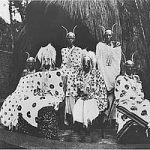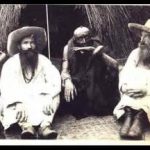The Traditional Political System
The Banyarwanda (sing. Munyarwanda), were organized into a true monarchic state. The head of the state was a ruling monarch called the Mwami. The powers of the Mwami, however, were not complete without those of the Queen-mother who reigned with him. She could, in fact, be the true mother of the Mwami, but not necessarily. If a Mwami’s true mother died, for instance, she was immediately replacedby another woman of the Abega clan chosen by the Abiru (Keepers of the tradition). The powers of the Queen-mother put a check on those of the Mwami and vice versa. Her prerogatives were enhanced by the fact that she had to be a member of the powerful clan of the Abega, a rival clan to the royal clan of the Abanyiginyaof which the Mwami was a member. The opposition and influence of the Abega often turned the course of Ruanda history. For instance, in 1896, the Queen-mother’s brother, Kabare – an Umwega and head of the Queen-mother’s lineage — had the Mwami assassinated and replaced by the Queen-mother’s own son who was an Umunyiginya also and eligible. It was this man, Musinga, who during the long years of his reign, resisted the Europeans and was finally deposed by the Belgians in 1931. The Mwami’s rank was hereditary and was passed on from father to son or brother to brother within a lineage of the Abanyiginya(A person of that clan is Umunyiginya; several persons are Abanyiginya; “Totem” for the clan is the crested crane).
The political organization under the Mwami was pyramidal. The Mwami had councils of various sorts about him, among which was a council of the provincial chefs, who were, for the most part, also his vassals. His vassals were not necessarily chiefs, however.”
Each provincial chef had under him, according to Dr. Jacques Maquet, a “Land chief” and a “Cattle chief.” The chief also had under him sub-chiefs who were for the most part his vassals — but all his vassals were not necessarily sub-chiefs; these men — his vassals and sub-chiefs — could be vassal to other chiefs, or to the Mwami himself, at the same time.
The two institutions of chieftainship and vassalage (the latter called ubuhake in Kinyarwanda), were distinct from each other, although irretrievably intermeshed. Ubuhake was the institution through which an individual, be he peasant or herder, commended himself to a lord. The lord gave protection and support; he also gave the vassal rights to exploit a certain amount of land, and he gave him a cow or cows. The vassal, on the other hand, swore fealty and recognized unto himself duties of homage, payments of dues in kind, labor, and service in general. The mode of such duties varied with his rank. If he was of the higher nobility, he could delegate inferiors to perform the actual duties for him; if he was a peasant, he had to serve and contribute with his family’s aid.
Ubuhake was distinct from the administrative structure in the sense that a peasant, for instance, could be “the man” of a Tutsi of his own or another community, and not that of the chieftain of his own Hill, although he also owed that chieftain obeisanceand certain duties. On the other hand, ubuhake was identified with the administrative system in that a chieftain himself was,by definition, a person who was vassal to some more powerful person. Or to the Mwami himself, and he usually had received the Hill as fief, in which case he was most likely to become the lord of all the nobles of his Hill and indirectly through them — or directly — that of the peasants of his Hill.
Both systems of relationships, however, ended with the heads of shallow lineages at the base of the hierarchical pyramid. The accounts for all these relationships were recorded and rack-oned by means of a complex system of exchange of cows.
Theoretically, the Mwami was the “owner” of all of the cows of Ruanda, as he was “master” of the land. Just as the Mwami handed down cows to various individuals, various duties and rights over the land went along to the man who was to pasture the cow or cows.
The Mwami could, through his chefs whom he made his collectors, collect taxes in the form of foodstuffs, weapons, beer, etc. The chiefs would collect from the sub-chiefs, who would collect from the heads of households. Each tax-farmer at each level would demand more than was required of him and keep the surplus for himself. The Mwami could demand cows in the same way; the same system of redistribution applied to cows, but their case was special.
This traditional administrative structure was almost exclusively composed of nobles — it must be remembered that the commoners who “crossed the line” were eventually absorbed — and was organized to exploit the peasantry. Through dues in kind and corvée labor, the agricultural production and labor of the peasant commoners came up the structure to the Mwami, liberating thenobility from productive activity. The greater part of the lime of the male nobility was taken up by the exigencies of paying court, either to a superior lord, or to the Mwami himself, or to bath. Much of their time is said to have been taken by war, but, again, it must be pointed out that a great part of the armies were the peasant serfs, whose duty if was to accompany their lords to war.
The Mwami had some additional contrail over the armies in thatthe sons of the larger families of the nobility had to be sent to the Mwami’s court for a period of training. These young men (Intore)formed the cadre of new armies.
Within each province, the able-bodied nobles had to be part of an army along with their clients; that is, if a peasant lineage head was one of the clients involved, he and his lineage were involved. The chief of a provincial army could be, but was not necessarily, the chief of the province.
Whether the military structure had been important or not, the fact remains that, after European occupation, it never offered great resistance and became obsolete.
Ruanda was politically fragmented among a multitude of small chieftains over lording a like number of Hills. The occupying power established a program of progressive consolidation, which, similarly, allowed the elimination of the “incompetent” chieftains. The European administration interfered with the traditional political system more strikingly at times, as, for instance, when the Mwami Musinga was deposed and replaced by his son Mutara. The Mwami was “advised” and he ruled by edicts which to be approved by the European administration; rules and regulations came from that administration through the Mwami.
Thus it was that, officially, dues in kind and in work were gradually replaced by taxes and salaries; the chiefs (up to the Mwami), became salaried persons and were paid by the European administration, releasing the peasants from these obligations. The peasants, by 1944, could “buy” their labor away from their patrons, or their chiefs, or both. This, of course, is the theory. Eventually, in 1954, always acting on “advice” of the Belgian Residence, Mwami Mutara Rudahigwa abolished the institution of ubuhake. The edict stated that the vassals were now to keep two-thirds of the cows that they had received from their lords and were to give up one-third, and that the lord-vassal relationship would thereby be dissolved. This did not work out too well at first because, obviously, it had not been considered that more than cows were involved — there was also land (Shortly after this occurrence, the peasants were given full title to the lands they worked, but the acreage was limited by a ceilingvarying with the region in which they lived. In Gisaka (and therefore in Remera), this limit was two hectares — equivalent to five acres — per household, but, obviously, because of inheritance patterns, family administrative structure, etc., it was impossible for each adult male to have exactly two hectares of land. Some had more, some had less. Moreover, the idea of real ownership of land had not penetr
https://uk.amateka.net/the-traditional-political-system/https://uk.amateka.net/wp-content/uploads/2021/03/monarchie.pnghttps://uk.amateka.net/wp-content/uploads/2021/03/monarchie-150x150.pngModel CitizenshipThe Banyarwanda (sing. Munyarwanda), were organized into a true monarchic state. The head of the state was a ruling monarch called the Mwami. The powers of the Mwami, however, were not complete without those of the Queen-mother who reigned with him. She could, in fact, be the true mother...BarataBarata rpierre@ikaze.netAdministratorAMATEKA | HISTORY OF RWANDA




